
A sampling of some of those animals one may encounter in the East Tennessee Area
Although some will only be seen in our Parks & Wilderness Areas, many have adapted well to the changing urban & Suburban environment.
or

The Woodchuck is known by many local names, among the best known being ground hog, whistle pig, and eastern marmot.
The woodchuck is a member of the widely distributed marmot clan, and is actually a big, clumsy, ground dwelling member of the Sciuridae, or squirrel family. It seems somewhat odd to associate the srnall tailed, heavy-bodied burrow-digging woodchuck with the large-tailed, slender, tree-climbing fox or red squirrel, but if we remember also the various chipmunks, gophers, and ground squirrels the transition is easier to understand. The woodchuck occasionally reminds us rather sharply of his squirrel ancestry by climbing a tree to escape dogs or to keep a better lookout over his home territory.
Woodchucks may be called typical hibernators, or winter sleepers. When the temperature begins to drop in late fall, the woodchuck, fat as a Thanksgiving turkey, crawls down to his underground hole, pulls the hole in after him by caving in the dirt in the passage to the nest, and goes to sleep for the winter.
During this period of hibernation, nothing is eaten, so that no fuel is received to be converted into bodily heat by the oxidation of the blood through breathing; on the contrary, the lungs almost cease to work. There is an occasional respiration-a sighing inhalation of breath-but most of the time the only oxygen in the lungs is the trifle reaching them by the slow heart beats, and by the diffusion of gases.
Contrary to tradition, woodchucks do not emerge from their winter sleep promptly at sunrise of February second, to watch for their shadows on the snow or earth as the case may be. They do seem to become restless and awaken more and more frequently during late winter and early spring, finally coming out to stay when the snow is gone and tender shoots are starting in the fields.
The mating season is believed to be in late March, and the young are born in late April or early May. Very small and undeveloped at birth, probably blind for about a month, they do not venture from the den until they are six or seven weeks old. They begin to eat solid food in the form of grass and clover as soon as they are able to get out to find it. The mother, or both parents, attends them carefully at first, showing them where and when to eat as well as some of the dangers of the outside world.
Woodchuck burrows may be found in woods or fields, but perhaps the most favored location is at the edge of a wood or swale adjoining a field of clover or alfalfa. One entrance to the burrow is marked by a heap of dirt thrown out during the excavation, but one or more other entrances without external evidences are often present also. These concealed openings are used as lookouts or spy holes, and here the 'chuck watches intruders whose attention may be attracted by the obvious pile of dirt, while the 'chuck himself remains undetected. The length of the burrow varies according to the type of soil and surface topography. The total length may be somewhere between seven and 50 feet, and a depth up to six or seven feet.

The striped skunk is about the size of a house cat, with a large, deep body, small head, and short legs. The hair is long and black, with a broad white patch on the head and shoulders. Two white lines forming a "V" from the shoulder area may extend part way or all the way to the base of the bushy tail.
This species probably has increased in numbers since pre-settlement times as more forest land has been cleared. The skunk prefers a semi-open habitat of mixed woods, brush, and open grassland within two miles of water. Management practices which encourage interspersion of these vegetative types will favor skunk populations, but the adaptable skunk can be found in almost any habitat, including suburbs and city parks. The den mav be in a ground burrow or beneath a boulder, rock pile, wood pile, or abandoned building. Almost any dark, dry, sheltered site will do. Young skunks are taught to hunt by their mother, and in late June or July are often seen walking single file behind her at dusk-off an evening's feeding and training. Skunks make a variety of sounds: at times they may be heard to twitter, screech, growl, churr, coo, and whistle.
Striped skunks do not hibernate. In December the females den up, sometimes eight or ten to a den. Males are more solitary. During periods of extreme cold they may stay inside for days at a time, but a warm spell will bring them out in search of food.
The skunk is perhaps best known for its well developed scent glands, situated at the base of the tail. When seriously threatened, the skunk can squirt the musk from these glands with great accuracy up to 15 feet. Gentle breezes can carry the scent more than a mile. The musk is yellowish, has an acrid, stinging odor, and sticks like glue. It is not only offensive to the nose, but also painful to the eyes. Tomato juice is the best treatment for the skin of one unfortunate enough to be sprayed; scented clothing is best burned.
With such an effective defense mechanism, the foraging skunks wanders to and fro, seemingly oblivious to danger. Few predators will attack a skunk, the great horned owl probably takes more than any other natural enemy. Skunks are often observed along roadsides, and many thousands fall victim to the automobile each year.
The striped skunk is an important furbearer, and also is one of the most effective predators of small rodents and insects. An occasional individual will attack poultry.
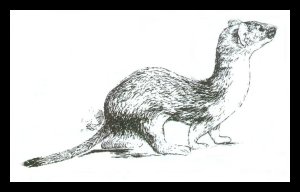
The weasel resembles the mink, but it is smaller. Weasels are extremely aggressive and fearless for their size. Although they have been known to kill poultry. they usually rely on mice, rats, and other small animals for food. They often live in burrows made by chipmunks or under farm buildings. Weasels are in the same family as skunks, and possess a scent similar to that of the skunk.

The raccoon is a medium-sized animal with grizzled gray-black fur, and is easily recognized by its black face mask and alternating rings of black and yellowish-white on its bushy tail.
Woodlots with neighboring wetlands support the highest numbers, but this highly adaptable species can succeed in most habitat types, and even in close proximity to man.
The raccoon's diverse diet is made possible by its ability to crush hard foods such as acorns and shellfish with its large, low-crowned molars. Although it does much foraging in water, and sometimes will dunk its food before eating, food washing is not an invariable practice - many items are consumed unwashed, just as they are found.
Large, hollow trees in woods are preferred den sites, but the nest may be in a ground burrow, rock crevice, drain tile, or old building. After mating, the male shows no interest in family life, and leaves all responsibility for rearing the young to the female.
Raccoons are fairly sociable with their own species, and often den with others. They do not hibernate, but during severely cold weather they may nap for long periods in a secure shelter. Warm weather will send them out food gathering again.

The cottontail rabbits are among the best known wild animals. They are found in fields and woodlots, and furnish hunting recreation for the largest number of Tennessee hunters. They are found throughout the state, with greater numbers found in the southern part of the state.
The cottontail is strictly vegetarian, eating green plants in great variety. The cottontail feeds on the bark and twigs of shrubs and young trees, especially in the winter. They are most active at dusk and at night, hiding in the grass and thickets during the day, where their coloring blends into the surroundings.
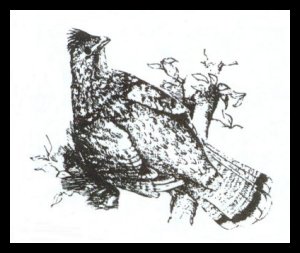
Grouse are about three times the sire of quail and have a coloration that blends in with the autumn leaves. During the mating season, males produce a distinctive drumming sound, made by beating their wings against the air. Grouse eat a wide variety of foods, ranging from tree buds to insects. They are most commonly found in large tracts of wooded lands.
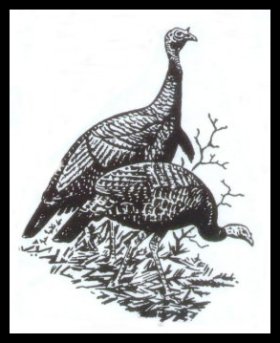
The wild turkey is an extremely wary bird, and usually it prefers solitude. They are found in more remote wooded areas away from the presence of man. Wild turkeys resemble their familiar domestic relatives, but are more streamlined in appearance. They are glossy black in color, with a bluish, featherless neck and head. The male is larger than the female and is recognized by the bristly black beard hanging from the chest.
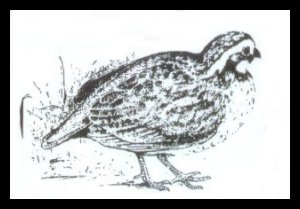
The bobwhite quail first began to thrive after the early settlers cleared the vast forest areas of the state and turned the land to farming. The bobwhite has adapted well to farmland, and it does best where land is under cultivation. While farms and fields were small and good cover available, the bobwhite flourished. However, farmers now have huge fields with no brush or weedy fence rows to provide needed shelter, and populations of quail have declined. The ideal situation consists of a combination of fields of different types of farm crops and patches of good cover. Grassy areas where it can nest without being disturbed are essential to the bobwhite. The eating habits of the bobwhite make it a highly desirable bird to have on the farm. It is known to eat a great variety of insects and weed seeds, as well as the waste corn, wheat and other grains that it finds.
The early settlers hunted and trapped quail for food rather than recreation. Now the situation is reversed, since they are not as important a food source as they once were. The value of quail as food, however, should not be overlooked.

The white-tailed deer possesses a reddish colored coat, which turns gray-brown in the tall. The bucks shed their antlers each spring, but by autumn they have grown back. Deer usually rest during the day and move about at dawn, dusk or at night They feed upon leaves, twigs and tree seedlings. During the Winter they depend heavily on acorns On occasion, deer can become a nuisance by feeding on Crops. Control measures are sometimes necessary
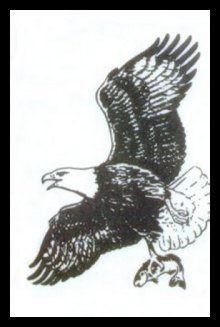
Principle food of the Bald Eagle is fish which it catches itself, finds dead or takes away from the osprey

The North American porcupine is also called quill-pig, prickle-cub, porky hog, and quiller.
No detailed description of a porcupine seems necessary as everyone is familiar with the chunky body and formidable spiny armor of the animal.
Porcupine quills are rather remarkable things, but they are attached to the skin, and there is no mechanism by means of which they can be hurled like a javelin. Quills are about one inch long on the head, and four inches on the back. They are absent from the muzzle, the underparts, and the legs. Each quill is sharp and smooth at the tip, but finely barbed for some distance below the tip. These quills can be erected by voluntary muscles under the skin, and are most formidable weapons of defense. It is estimated that a porcupine is equipped with about 30,000 individual quills.
While the quills on the back of the porcupine are purely defensive weapons, since an attacker must actually push against them to be hurt, those on the tail are offensive as well. The tail quills are loosely set in the skin, and when the tail is lashed against an enemy the quills attach themselves very readily to the intruder. Then the barbs begin their function, and each quill tends to work its way into the flesh. Not only does this cause festering and pain, but if the quills enter the body cavities they may cause death as well. The possession of this tail weapon leads to a ridiculous appearing, but none the less effective, maneuver on the part of the porcupine, for he literally backs into battle, swinging his tail in advance like a medieval mace.
In summer, porcupines eat all sorts of leafy vegetation, and are particularly fond of lily roots and such other aquatic vegetation as can be found along the edges of lakes and streams.
In winter, the food consists largely of the bark and twigs of hemlock, aspen, jack pine, elm, basswood, etc., although hemlock is perhaps preferred to all else.
Porcupines are also notorious for their "salt tooth." They are so eager for salt that they will gnaw anything with an iota of briny flavor. Many persons have found their forest cabins practically ruined by these animals.
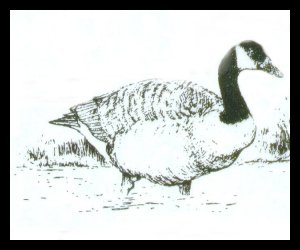
The Canada goose is readily recognized by its black neck and head and prominent white cheek patches. The back and wings are graybrown to dark-brown and the sides and breast are light gray to dark brown. Bill, legs, feet, tail, and rump are black; the belly, flanks, and tail coverts are white. Male and female have similar plumage. Eleven subspecies of the Canada goose are recognized.
Geese have benefited from the grain provided by agriculture, but they also need marshes and other wetland habitats throughout the year. The primary nesting grounds are in the remote tundra and muskeg habitat of the Canadian Arctic and Canada. Nesting sites are diverse: muskrat houses, dikes, cliffs, creek banks, islets, hummocks of marsh vegetation, abandoned osprey and heron nests, and artificial nesting platforms are all used. Nest site requirements include proximity to water, cover for the nest, and an exposed view for the incubating female.
Canada geese remain mated throughout the year. Nesting activity begins with the lengthening daylight of approaching spring. After the adults have selected a nest site and established a nesting territory, they drive away their young of the past year. The gander then aggressively defends the female, the nest, and the nesting territory from all intruders.
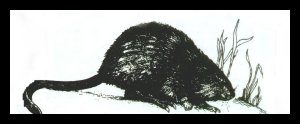
Muskrats are usually present in our state wherever there is water in lakes, ponds, or streams. They have become well adapted to civilization, even living in streams which flow through cities. Two kinds of homes are built, either a simple hole under water leading up into a bank, or a house which is built in marsh areas. These houses are made up of cattails and brush gathered from the marsh. The houses vary in size, from one to three feet or more above the water. Muskrats feed chiefly on aquatic vegetation. Their fur is a rich chestnut brown above and much paler and grayer underneath. The flattened rat-like tail is black. Because of their abundance more muskrats are harvested than any other fur bearer.
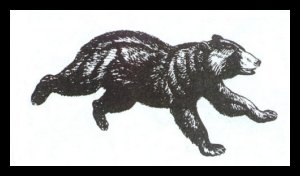
Though clumsy in appearance the black bear can move swiftly when necessary. For a short distance it can run at a speed of up to 25 miles per hour.